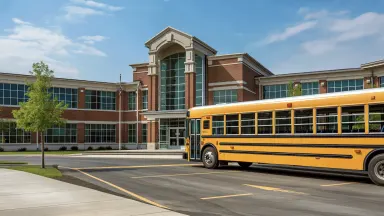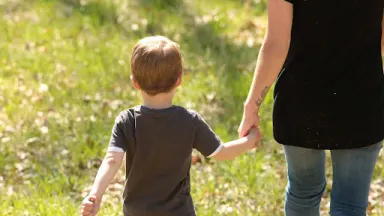Building a Culture of School Safety with The "I Love U Guys" Foundation
Today’s security leaders know protecting people isn’t just about tragic events—it’s about readiness and risk mitigation for any crisis, anywhere.
These challenges run the gamut—from operational incidents like a gas leak or even a “moose on the playground,” to severe threats such as an active shooter. My podcast guest, Pat Hamilton, Alliance Director at The “I Love U Guys” Foundation, has seen all of these and more.
Over two decades, they have developed best-in-class methods and protocols for proactive preparedness to help schools face any challenge. With a focus on foundational safety principles—such as clear communication and easy-to-follow steps— their strategies for schools offer lessons that can be applied across all environments.
Mission in Action: Protecting the Joy of Youth
The “I Love U Guys” Foundation is on a mission to restore and protect the joy of youth through educational programs and positive actions in collaboration with families, schools, communities, organizations, and government entities.
The foundation was started in 2006 by Ellen and John-Michael Keyes following a school shooting that took the life of their daughter, Emily. On that day, Emily sent two text messages... One to her mother, Ellen, “I love u guys. K” and to her father, John-Michael, “I love you guys.”
For Pat, this work is both deeply personal and universally critical.
“It’s been much more personal than I expected,” said Pat, who has worked closely with the family since 2009.
At the time Emily lost her life, Pat was Director of Safe and Secure Environments at Adams 12 Five Star Schools, working about an hour away. Emily’s aunt, Heidi, was a sergeant for the Broomfield Police Department. She oversaw the School Resource Officer program for Pat’s district.
They saw the chaos firsthand. Pat noted, “You could have a high school on one end of town using ‘code red’ and a high school on the other end using ‘lockdown level 4,’ all served by the same police. Imagine the confusion that was being created there.”
Together, they embarked on an 18-month project to improve emergency response protocols for their district.
“The result of that was a video that came out at the time. It was a DVD, that’s how long ago this was, back in 2008, and it had a classroom discussion guide,” said Pat.
When Heidi showed the program to her brother, John-Michael, he recognized how impactful it would be to develop a common lexicon for schools across the country.
“They knew that if they could get their arms around that and create this common lexicon, that they could make a difference. And that’s what they’ve done,” said Pat.
The Standard Response Protocol (SRP): Five Actions for All Hazards
What started as a DVD for a single school district became the foundation of the Standard Response Protocol, an institutional, all-hazards approach offering five specific actions that can be performed during an incident.
The Standard Response Protocol uses clear, plain language for students, staff, and first responders during a crisis. This enhances communication and consistency when it matters most.
Hold is followed by the Directive: “In Your Room or Area” and is the protocol used when hallways need to be kept clear of occupants.
Secure is followed by the Directive: “Get Inside. Lock Outside Doors” and is the protocol used to safeguard people within the building.
Lockdown is followed by “Locks, Lights, Out of Sight” and is the protocol used to secure individual rooms and keep occupants quiet and in place.
Evacuate may be followed by a location, and is used to move people from one location to a different location in or out of the building.
Shelter and state the Hazard and Safety Strategy for group and self protection.
Lockdown: The Power of “Locks, Lights, Out of Sight”
While the SRP applies broadly, Pat highlights the need to spend extra time on lockdown procedures during training. He emphasizes that ‘Locks, Lights, Out of Sight’ is the primary life-saving approach to a threat, such as an active shooter, inside a building.
Gun violence remains a critical issue for schools. According to the Washington Post, since April 20, 1999, when the Columbine High School massacre took the lives of 13 innocent people and injured 21 others, there have been 435 school shootings. In 2024, they recorded 34 instances in which a gun was fired or brandished on school property during school hours. That number is up from 2023, when there were 32 recorded incidents, but down from the all-time high of 46 school shootings in 2022.
In the foundation’s research, they find only three cases where someone lost their life behind a locked door during an active shooter situation. In all three—Red Lake, Minnesota; Parkland, Florida; and Emily’s case—the lock itself did not fail. Instead, entry was gained by shooting through a window, targeting visible people, or by the perpetrator already being inside the room before the door was locked.
“We know that when we take fast action, we get people behind a locked door, their lives will be saved,” said Pat.
Modern technology is playing a key role in improving the speed at which schools can enter a lockdown.
“We shot a video years ago in Adam’s 12, and all we did was turn on a video camera to one of our admin people and said, ‘Hey, I need you to lock this door,’ and that was enough of emotional stress to start to impact motor skills,” said Pat.
Electronic locking technology removes this human factor, ensuring an immediate, system-wide response at the push of a button.
After the Crisis: The Standard Reunification Method (SRM)
After any crisis, schools need a method to safely and efficiently reunite students with their parents. According to Pat, this process is often overlooked.
Using a guide developed by a Texas school district, The “I Love U Guys” Foundation created the Standard Reunification Method (SRM) in 2012. The SRM is a formal, adaptable process. It ensures a safe exchange of custody between the school and an authorized parent or guardian.
Whether a school utilizes paper-based kits or emerging technology, Pat emphasized the importance of training the community on reunification procedures in advance.
“We want to make sure that your students are safe and that we have a safe exchange of custody,” said Pat, “I’ve had 30 successful reunifications, but never a perfect one. Always room for improvement.”
Emily’s Legacy: A Force of Nature
Today, the SRP and SRM are used in more than 50,000 schools and organizations worldwide, with 10 states officially adopting the program. All downloadable materials for its programs are available at no cost to remove financial barriers to adoption.
Reflecting on Emily’s legacy, Pat says seeing a standard response protocol poster in unexpected places is a ‘goosebump moment.’
“I love the story that John Michael and Ellen tell about their daughter, so she came downstairs when she was a young teen and had basically created her own brand. She had made this drawing, and she said, ‘Well, anyone who’s going to change the world needs to have a brand,” said Pat. “I think that that just speaks to– she knew that she was going to be a powerhouse and a force of nature, and she absolutely is.”
Join the Conversation
The wisdom shared by Pat Hamilton and The “I Love U Guys” Foundation underscores a vital truth: safety is everyone’s business. It requires a proactive, collaborative approach that integrates clear communication, best-practice training, and smart technology. If you are a security leader, facility manager, or concerned community member, we encourage you to listen to the full episode of the Vantage Points podcast with Pat Hamilton and explore the Foundation’s powerful, free resources.
Learn more about The “I Love U Guys” Foundation’s mission and programs here.






